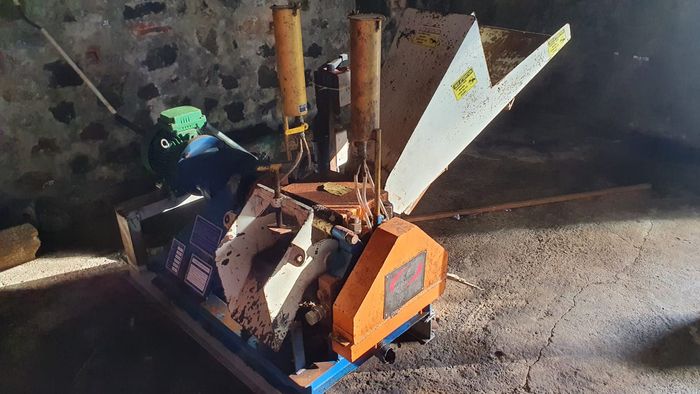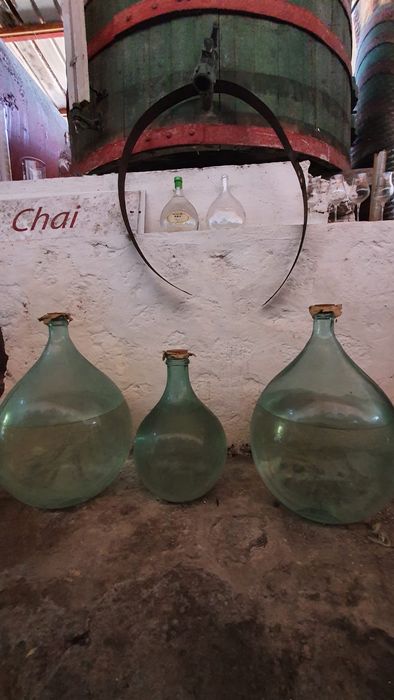
Habitation Beauséjour has a history that dates back to the end of the 19th century. However, it is now the youngest of the Martinique distilleries. After a long period of inactivity, a handful of enthusiasts took up the torch and have been producing agricultural rum again for almost 2 years. Karl Agostini, distiller and cellar master, gives us an update on this adventure. He tells us more about HBS rum.
Hello Karl, and thank you for being here early in the morning to chat with us. What work awaits you today on Habitation Beauséjour? Do you plan to distill? When do you harvest?
We harvest all year round, since we are not governed by the AOC specifications because we produce in a still. There are many things to do, including cellar work: reduction, tasting the products to see if the aging is going well, etc.
There is also a bottling of the next vintage which is in the process of being done, plus all the little DIY jobs to be done here and there in the distillery, so there is plenty to keep you busy!
So what is this next HBS vintage?
This is a vintage that will probably come out around November, depending on how long it takes us to finish bottling and put the labels on, because we do everything manually. It has some very big particularities, firstly because it will be the first vintage at 50 degrees, instead of 55. The reason for this is clear: we had chosen 55% because it is the original degree of Martinique , but tastes have changed over time. Other people like rum, many more women too, so we had to adapt the alcohol level.
The other particularity is that unlike the other vintages which were reduced between 4 to 6 months, we are on a rum which will be reduced much more slowly. We are therefore on something which took about 8 months of reduction.
Perhaps this demand for a lower alcohol content also corresponds to a changing consumption pattern? Today, people also want to be able to consume dry white rum, and not necessarily in a ti'punch?
Absolutely, but in any case we invite everyone to first taste our pure, dry rums, before adding sugar or lemon. This allows us to know exactly what is in the product, because often the aromas of sugar or lemon are naturally present in our vintages.
There has been a big craze around rum for a few years. More and more people are interested in it. Before, Martinique rum was mainly for Martinicans or West Indians. Today, we have a West Indies with a more diverse population, who are interested in rum and who are more interested in 50% than 55%, while the palate gets used to it, so to speak.
The 50% therefore corresponds to a demand. It is also a big thought for women, who are often a little reluctant to 55. The force is felt all the more since we produce in a still. So with a high degree, this can be a brake for some people.
Perhaps it is mainly the number on the label that is scary, because when the product is well made, the degree is really secondary...
Absolutely, and often when tasting people don't know that it's 55%. It's when they look at the label afterwards that they get scared. But if you don't tell them about the strength at all, they of course think it's a little strong and put that down to the still rather than the alcohol. But they don't realize the 55% at all and it goes down well.
I would like to go back a little: could you tell us about your career before arriving at Habitation Beauséjour?
Basically, I don't come from rum or spirits at all, but rather from agronomy and horticulture. I came to Martinique to study, a BTS in agronomy. After that, I returned to mainland France to do an engineering school in horticulture, then after that I decided to come back to Martinique. I started working in the field in which I trained, and then I wanted to see other things.
It was Arthur de Lucy who called me, telling me that he had set up a new distillery, and that he was looking for a distiller. At the time, I was living in Le François. So the road scared me a little, but I came to visit anyway and I fell in love with the setting and the work. So I decided to make the road every day 🙂
Did you learn fermentation and distillation on the job, or were these things you were able to learn during your studies?
During my studies, I learned about sugar cane cultivation, which I knew like the back of my hand. However, I knew absolutely nothing about the processing part. So I learned on the job, first with my predecessor who was also self-taught. And then I read all the scientific publications I could find on the subject, to have as much information as possible on how fermentation and distillation worked. I also learned the terms, what esters were, cane wine, vesou, the difference between a still and a column, etc.
Afterwards, I did the AOC training with Marc Sassier, during which I learned a lot of things. It was really great to learn to recognize tastes, to know how to recognize a rum from a cider for example, which may seem quite simple like that, but which when you are faced with a fait accompli, is much more complicated than you think.
This training helped me a lot, as did talking to a lot of professionals. So I also learned how the world of rum works. And then when we have a problem with our fermentation, our distillation, or even our aging, we simply ask another distillery. "I have such a problem with my barrel, can you give me a hand?" They are always there to answer, there is solidarity. I am not talking about competition between distilleries, because each one has its recipe, its product, its canes etc. They are all different so for me it is collaboration.
You also have a close neighbor, the JM distillery…
Exactly, we work a lot with JM , especially on the technical side, equipment monitoring, etc. And then Karine Lassalle is always there to answer my questions, so it's really nice to work with them. There's no waffle, when they can provide an answer, they do. They're always ready to lend a hand, so it's very nice.
Regarding the cane plots of Habitation Beauséjour, I read that they extended between 55 and 70 hectares. Where are you today?
Currently, all the canes we use are those from the house. We are still referencing all of this, but we are around 70 hectares. In these lands, there is cane, but also a forest of mahogany, mahogany, which we exploit from time to time. All the rest is cane, and we have several plots that range from several square meters to 3 hectares, all part of the AOC.
We cut by hand, we don't use everything. The rest of the unexploited plots are cut by machine by the neighboring distillery. We produce all year round, but our capacity is limited to 50 liters of pure alcohol per day. This corresponds to approximately 70 liters of 70% alcohol for a quantity of a little less than a ton of cane. We are therefore far from 70 hectares. For a plot of one hectare, we have about 35 weeks of cutting.
In addition, there is a lot of work to keep the plots clean.
There are a few plots that we have selected and that we keep for ourselves. These are the ones where the machines cannot go, for example the plots on the edge of the road, those that have a significant difference in level. Or plots that we have replanted with a specific variety that we like, or with an interesting exposure for us. The rest of the plots are intended for JM, for the AOC.
As an agronomist, how would you describe the terroir of Grand-Rivière, around the distillery?
Exceptional! (laughs) It is extremely interesting, firstly because we have a climate that is really different from the rest of Martinique, on the slopes of Mount Pelée. We could say the same thing about Neisson , which is on the other side, on the Caribbean side. These are two climates that are very different and that affect the cane. The land is not the same either. This Grand-Rivière terroir is very important. Already because it is a part of history, but also in relation to what was done before in terms of agriculture.
It is a land that is very rich, especially since there have been rotations. The distillery closed in 1958, and then there were avocados, a little banana. The land was able to rest and replenish nutrients etc. for several years, while benefiting from the various rotations that have enriched the soil.
And then we relaunched the cane. There are some plots of cane that are quite old. Some are 12 years old, which is much too old. That's why as the years go by, we try to replant the oldest plots. We do a lot of agricultural work, to cut, and either make an improved fallow, or replant something else, or simply put in another variety of cane.
You harvest all year round, and each rum you have released so far corresponds to a variety, and therefore to a harvest period. If you decide one day to release a “standard” white rum from Habitation Beauséjour, will it be a blend of the different harvest seasons, or will you choose a particular season?
It's an interesting strategy, but for the moment we're only a year and a half / 2 years old. The work, until now, was to be sure of our recipes, without necessarily relying on the season etc. Subsequently, the work will be plot-by-plot or varietal, like the last vintage in blue cane . This vintage was made with canes harvested during the rainy season. The first batch of the 2020 vintage was harvested during Lent, and the second during the rainy season. We can see the difference between the two.
So we know that there are differences between the seasons, we will exploit them. Afterwards, will we have a periodic "basic" white rum, based on a climatic period, I don't know. Maybe indeed in the long term. But for the moment we will already ensure a good base of recipes and canes. Then we could possibly start with a basic white rum, cut at a given period, and which no longer changes, or a basic white rum spread over the whole year.
You are still exploring…
That's exactly it, we are only 2 years old, we are babies. Even if the distillery existed before, many things have changed, whether it is the climate, the land, the techniques... We are not like a large distillery with 100 years of existence, which has been safe for years, with such cane at such a time which will give such a rum. We cannot afford to do that yet.
That's what's interesting. We like comparing vintages and cuvées! 🙂
Yes, and then if we always did the same thing, after a while it would be monotonous. I love experimenting with things, and anyway you never know what will come out of the still. When it flows, for 15 minutes there can be a certain taste. The next 15 minutes, it has another taste, etc., and that changes all the vintages.




Thank you for reviving these lands